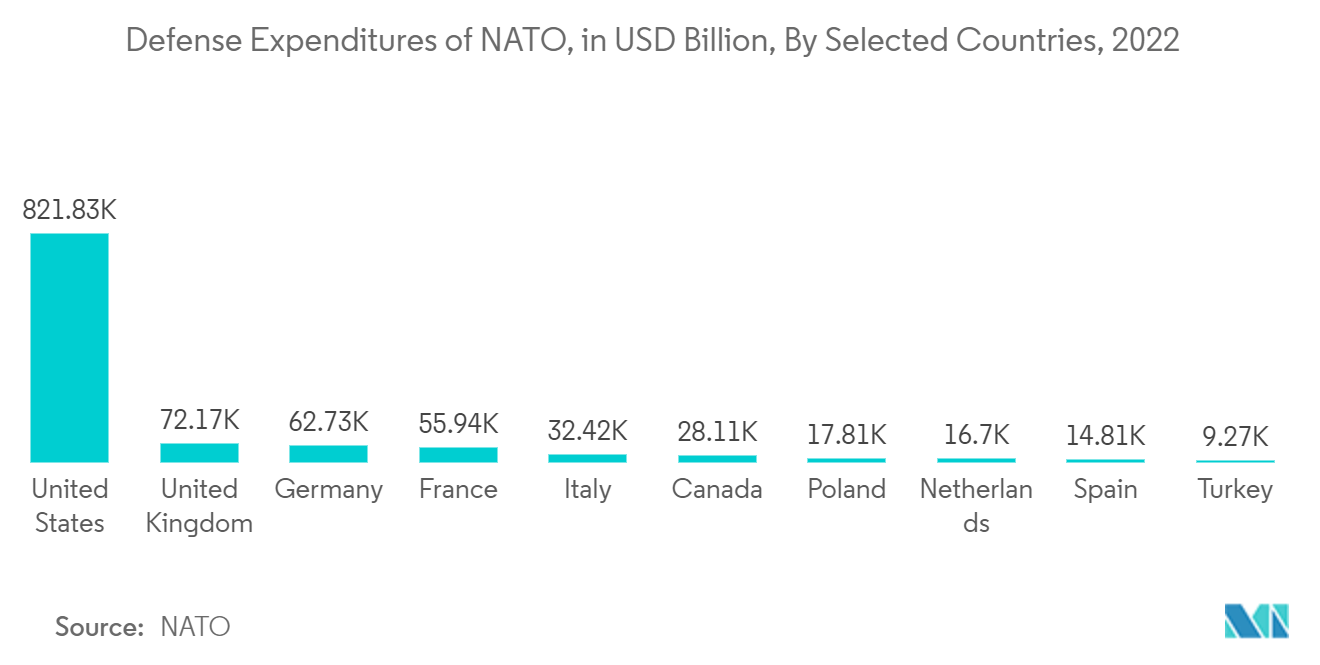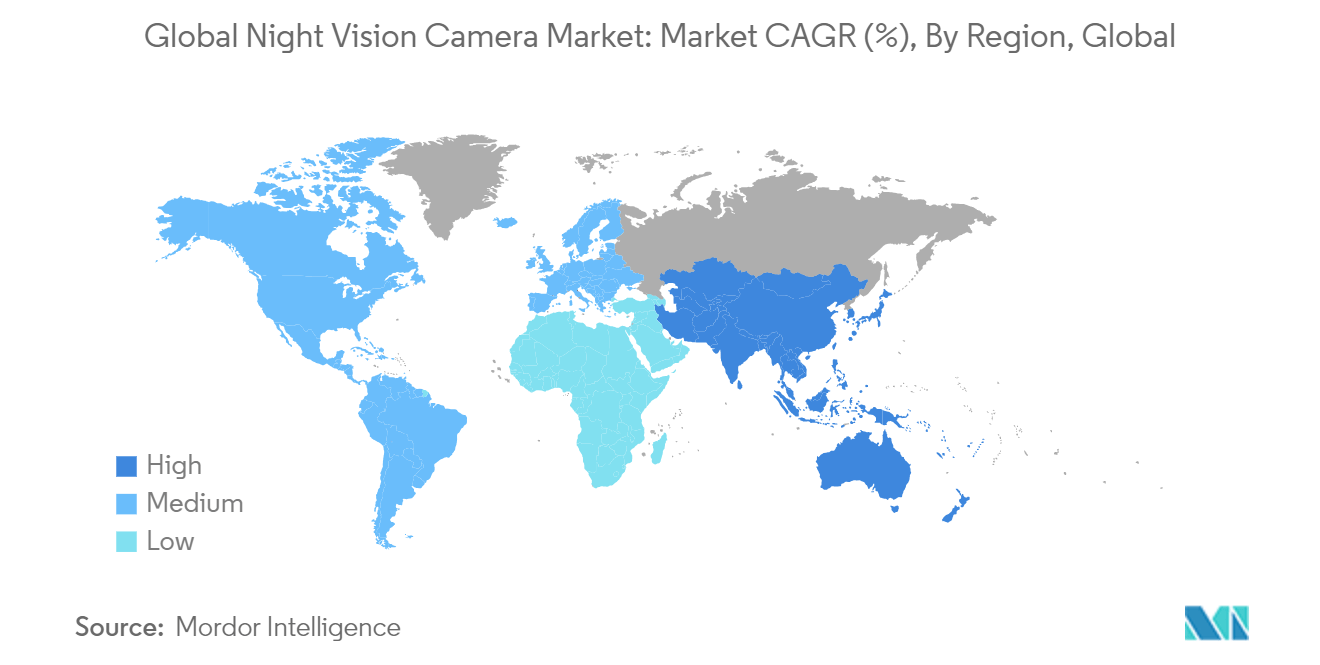Market Trends of Night Vision Cameras Industry
Military and Defense Segment is Expected to Drive the Market
- The widespread utilization of night vision devices in military defense and law enforcement applications is motivated by the necessity for enhanced situational awareness, target identification, and operational effectiveness in low-light and nighttime circumstances. Military forces heavily depend on night vision technology, with special forces utilizing night vision goggles (NVGs) in discreet missions like those undertaken by the US Navy SEALs during critical operations. Similarly, law enforcement agencies rely on night vision devices for surveillance, search & rescue efforts, and crowd control.
- Moreover, the countries are making significant investments in Military and defense, which requires the high use of vision cameras. Such investments are also likely to boost the demand in the market. For instance, In Feb 2022, The Finance Minister of India allocated INR 525,166.15 crore (USD 63.05 billion) to the Ministry of Defense for the fiscal year 2022-23. This represents an increase of INR 46,970 crore (USD 5.64 billion), or 10%, over the previous year's allocation of INR 478,196 crore (USD 57.41 billion) and the most significant rise in the defense budget in recent years.
- Similarly, In March 2022, According to draught budget recommendations, the Chinese government proposed a defense budget of JPY 1.45 trillion (USD 230 billion) for the fiscal year 2022, a 7.1% rise year on year. China's increase in defense spending coincides with the People's Liberation Army's increasing muscle-flexing in the vital Indo-Pacific. In 2020, China's defense spending, for the first time, crossed USD 200 billion. In 2021 the defense budget grew by 6.8% to USD 209 billion.
- According to the UK parliament, defense spending in 2020/21 was GBP 42.4 billion (USD 53.69 billion) in cash terms. This is a nominal rise of GBP 2.5 billion (USD 3.17 billion) over the previous year and a natural increase of GBP 1.7 billion (USD 2.15 billion). As a result, the yearly defense budget in 2024/25 will be GBP 6.2 billion (USD 7.85 billion) more in cash terms than in 2020/21. However, the real worth of this spending rise is lower, especially in light of growing inflation. Defense spending is estimated to rise by GBP 1.5 billion (USD1.90 billion) when adjusted for inflation.
- The United States military also utilizes AI-enabled night vision devices, which are affixed to a soldier's helmet and provide alerts regarding potential suspicious activity. To facilitate that decision-making, Secretary of Defense Esper launched a comprehensive Defense-Wide Review, which resulted in nearly USD 5.7 billion in savings for FY 2021, USD 0.2 billion in Working Capital Fund efficiencies, and another USD 2.1 billion in activities and functions realigned to the Services. This program enabled the Department better to resource higher-level National Defense Strategy (NDS) priorities.
- According to NATO, the United States will spend an estimated USD 821 billion on defense in 2022. As a result, their defense spending is the largest among NATO countries. The United Kingdom has the second biggest defense spending, at USD 72 billion s and germany USD 62 billion, france USD 55 billion.

Asia-Pacific to Witness the Significant Growth
- The Night Vision cameras market is expected to grow significantly in Asia-Pacific, owing to rising government spending on defense infrastructure for enhanced personnel capabilities. Further, with the development of new technologies, the cost of night vision devices is expected to reduce, enabling increased spending by the end-users.
- Researchers in different regions are experimenting with different materials to increase the efficiency of the products. According to the researchers, the ultra-thin film, constructed of a gallium arsenide semiconductor, might also be used to develop tiny and flexible infrared sensors. Though it is yet a proof of concept, the researchers believe it has the potential to be a low-cost and lightweight replacement for large night-vision goggles used in military, police, and security settings. A team of Australian and European academics created the film, and details were published in Advanced Photonics. It transforms infrared light, which is ordinarily invisible to humans, into visible light.
- Additionally, many governments prefer night vision capabilities for their smart camera installations. For instance, in March 2022, In India, the Delhi government intends to complete the final part of the CCTV camera installation project. Due to pandemic-related constraints, the public works department (PWD) claimed 1,33,000 CCTV cameras had been installed in the last two years, compared to a target of 1.4 lakhs. PWD intends to use 30-40 cameras to cover areas overseen by each market and resident welfare association. The four-megapixel cameras are installed on a pole or a wall and contain a night-vision feature for optimal video quality.
- The growing investment in security surveillance, especially in emerging countries, drives the demand for the studied market products. For instance, countries like China and India increasingly invest in these technologies, motivating foreign and local manufacturers to invest in the market. This is bringing advancement and innovation into the studied market. Moreover, regional companies are raising investments to develop and produce night vision devices. In April 2022, Shenzhen GD Digital Ltd., based in China, launched a Kickstarter fundraiser for GAODI night goggles, a compact, lightweight night vision solution with dual TFT 1.4-inch displays, offering a resolution of 390 x 390. Such devices are likely to boost the demand in the market.
- High-quality intelligent video surveillance would be the future of the security industry. With the introduction of new advanced technologies, the functions of today's surveillance systems are becoming more sophisticated and smarter. With the integration of several techniques: networking, multi-core processing, digital signal processing, image processing, and high-capacity storage, intelligent surveillance systems have and would gradually replace older systems. Which will provide significant growth for night vision surveillance systems in the future.

